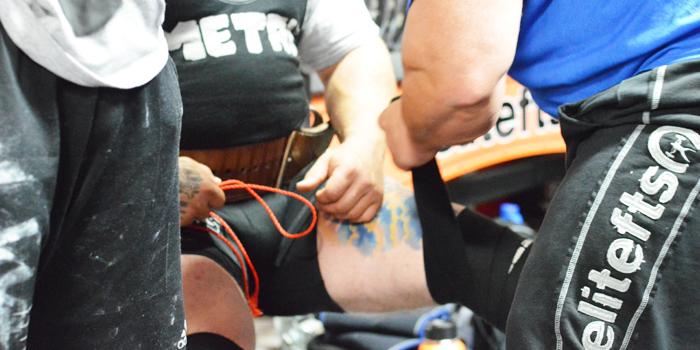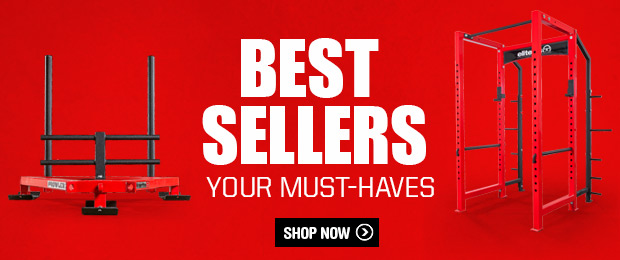
As part of the elitefts Q&A, we constantly see questions (typically from raw lifters) about how much weight a powerlifter can reasonably expect to add to their squat simply by wearing knee wraps. I think we've all heard stories of an incredible lifter who gets hundreds of pounds out of knee wraps.
But do these kinds of lifters actually exist? Imagine if you could take your squat from 550 to 700 simply by learning to use your knee wraps correctly. Seem believable?
Most lifters and coaches will tell you no. Cutting through gross exaggerations and inspirational BS, Swede Burns has standards for what kind of weight improvement indicates a lifter is properly using knee wraps. He can tell you whether you fall within an acceptable range of carryover, or if you have no clue what you're doing.
In an email exchange with Marilia Coutinho regarding one of her champion lifters, Swede Burns took on the idea of carryover from knee wraps. Using one specific lifter as an example, Swede explained the concepts of kinetic energy and how the mechanical system of the squat requires a lifter understand the execution of proper movement patterns.
WATCH: The Comprehensive Guide to Knee Wraps
Marilia:
I am facing a challenge and would like to ask your opinion. Actually, maybe you can even share this with other people who might have the same question.
My buddy Hugo is pretty new to powerlifting. His first meet was in October 2013. He was in the 220-pound class and raw. The following year we moved up to the 242-pound class. We had 12 weeks to train with wraps.
His strong lift has always been the deadlift, in which he did a nice 322.5-kilogram (711-pound) and got the IPL World Record, but his squat was 250 kilograms (551 pounds)with wraps.
Six moths earlier he had squatted 220 kilograms (485 pounds) in the 220-pound class. Therefore, his knee warp carryover is not that great: only 14%, considering only the numbers (and not the fact that he moved up a weight class.)
I was hoping he would now move faster towards the 300-kilogram (661-pound) range, but his last meet was even more frustrating: only 260 kilograms (573 pounds). We are wondering if you have ever seen something similar among your lifters. I have hopes, since many of your boys look like Hugo.
This is a critical moment: 23 weeks before IPL Full-Power Worlds. We are still in a preparation block, but we need to decide whether to go with wraps or raw now.
Swede:
Here are my initial questions for you.
1. How much of the squat training is being done in wraps?
2. How much work per year is the lifter doing with no wraps, if any? When was the last time a cycle of no-wrap training was done?
3. Do you have videos of training or competition squatting in wraps?
4. You mentioned that Hugo is getting 14%, or roughly 30 kilograms (~75 pounds) out of the wraps, without considering that he moved up a weight class. 75 pounds is on the low end of "good" in regard to carryover from wraps only, but when we correct the potential increase of 22 pounds in bodyweight, that 75-pound increase becomes less than acceptable.
This leads back to my second question. Do you have an idea of his current raw one-rep max squat?
Marilia:
Here is a video of some of his squatting.
My replies to your questions:
1. Today was the first day we resumed wrapped squatting. We decided to use the long preparation period we have until the IPL Worlds in November to do some solid raw lifting before re-introducing wraps. Before that, when we were preparing for Las Vegas 2014, we did all strength day squatting with wraps (including supra-maximal work). Speed days were always raw.
2. Hugo doesn't have enough time into powerlifting for that many cycles to have taken place. So, his first was from October 2013 to May 2014, raw. His second was from May 2014 to November 2014, with wraps. His third was from November 2014 to now, raw.
3. See above video. Another lifter pointed out that Hugo does not use much elastic strength on the transition from eccentric to concentric. I hadn't observed that, but it seems so. He also has a significant inclination of the torso during all his squats. We made some changes on his stance and bar hold, but my concern was to get his movement to be more fluid (it looked segmented before). We feel it improved in this sense, but not in the torso inclination.
4. With three good reps with 222.5 kilograms (490 pounds), I'd say he's good for 240 kilograms (529 pounds) today. The championship in which he only did 260 kilograms (573 pounds) was two months ago, after he had done 280 kilograms (617 pounds) in training. That meet was screwed up and I have no idea what happened. They used a different bar and all the lifters had a problem.
Anyway, 40 kilograms of 240 kilograms would be 17%. Suppose his 1RM with wraps could be 290 kilograms. That would be a 50-kilogram (110-pound) hypothetical carryover.
RELATED Mistakes 101: Schedule Inflexibility
Today we went up to three reps with 240 kilograms (529 pounds) for three reps. He said it felt weird, so we tried a different wrap, which was a little better.
Swede:
Based on everything you've told me, and the video you shared, I believe Hugo's main issue is a very common cause for lack of sufficient carryover from wraps: not enough speed on the descent.
In a mechanical system, the work done by the net force always shows up as kinetic energy. In the case of a squat, your loaded body in motion is the mechanical system. The kinetic energy is what causes the rebound off the knee wraps. More kinetic energy means more rebound, assuming the lifter has the stability and strength to control the force exerted, and not crumble during reversal.
When I hear someone say, "I need more weight to hit depth in those wraps", my first thought is that they probably did not have enough speed on the descent. I routinely have lifters hit depth wrapped in training with 25% less weight than what they will hit in their meet with the same wrap job.
That is, first, how they learn proper technique to use the wraps and, second, how they will develop the special strength required to get the most out of the wraps. When I say "special strength", I am referring to the dramatically different strength curve of a wrapped squat compared to a raw squat. In order to build the appropriate strength to accommodate this different strength curve, the lifter should do the majority of their training in wraps.
Depth is not the issue in Hugo's case, but rather that he is not getting sufficient upward force to insufficient downward force hitting the bottom of the squat. Different issue, same cause.
I go as far as having my more advanced lifters perform all of their working sets in the exact gear that they will use in a meet, for two mesocycles prior to the meet-peaking cycle. If they compete in knee wraps and wearing a belt, all of their working sets during meet prep are performed wrapped, wearing the belt. Specificity becomes very important when carryover from equipment is a priority. I recommend you do the same, with a special focus on bracing the core during descent and improving downward speed.
I hope this helps. Please keep me posted and let me know if I can be of help in any other way.









